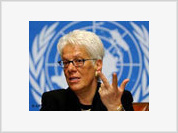Fact File: More State Support For Russian Exports
The central aim of Russia's trade policy is to create favourable internal and external conditions for exports. The ultimate purpose is to do away with its orientation on raw materials.
Various estimates say that 65 to 75 per cent of Russian exports today are made up of products with low added value, actually primary materials.
Russia ranks 17th in the world league table of goods exporters and only 31st in services export. The breakdown of Russian exports is as follows: oil 24.8 per cent, oil products 9.5 per cent, gas 17.9 per cent, ferrous metals 6 per cent, copper, nickel and aluminium 5 per cent, precious stones and metals 4.1 per cent, pulp and paper products 1.6 per cent, and machines and equipment 10.5 per cent.
More than half of exported Russian commodities (in money terms) is energy sources. Last year the fuel and energy complex was responsible for 56 per cent of all exports, metals industry 15 per cent, machines and equipment 7.7 per cent, chemical industry 6.5 per cent, and woodworking and pulp and paper industries 4.9 per cent. Most of the supplies are products with a minimum degree of conversion. To give an example, oil production in Russia has in the past three years increased from 6 million to 8 million barrels per day, while its exports rose from 3 million to more than 5 million barrels a day.
Another case in point is the forest industrial complex. Its exports are mainly round timber, and this with the export profitability of raw materials not exceeding 5 per cent, and that of plywood manufacture approaching 25 per cent.
According to Economic Development and Trade Minister German Gref, in the period between 1992 and 2002, Russia lost roughly half of its exports of hi-tech products. While earlier the export of machines, equipment and means of transport was about 25 per cent, now it does not exceed 12 per cent. The minister believes that no quick shifting towards the processing branches can be expected soon. The medium-range programme for Russia's social and economic development provides for an annual 1.5 to 2 per cent change in favour of the processing industries.
The recent 45th International Aerospace Show at Le Bourget confirmed Russia's leadership place in world arms exports. The exhibition saw a four-way agreement concluded between the aerospace heavyweight EADS, major European rocketry producer MBDA, AVPK Sukhoi and Rosoboronexport on cooperation in developing defence systems of a new generation, joint post-sale servicing of supplied aircraft and their upgrading.
In a rating list of 100 key world arms producers and exporters for 2002, published in News, the Russian military-industrial complex is represented by seven companies.
Our hi-tech military hardware enjoys invariable demand abroad. According to foreign media, the biggest buyers of Russian weapons are China and India. True, there are certain hiccups, since all settlement is done in clearing units. Most of their earnings the Russian exporters have to plough back into the production in those countries to stimulate their sales.
On June 22 of this year, Russia's Prime Minister Mikhail Kasyanov presided over a cabinet meeting which examined the concept of state support for Russian industrial exports. It was decided that from 2004 onward the government will issue guarantees for export projects. Next year's sum has been set at 500 million dollars.
Besides, subsidies for evening up credit rates include another 50 million dollars.
The Russian government is eager to settle conflict situations standing in the way of Russian exports. The Finance Ministry, for example, is protecting Russian property abroad from claims by the Swiss-based firm Noga. Two years ago, the Swiss impounded several Russian aircraft at Le Bourget. It looks, however, that the delayed litigation has every chance of being soon resolved in Russia's favour, with losses for Noga.
Russia's state policy of stimulating exports is becoming increasingly comprehensive and systemic. Companies exporting products are given both moral and material incentives. On July 11, the best exporters of the year were given awards at the sixth ceremonial procedure. Prizes went to 16 winning companies that range from instrument makers to agro-industrial producers.
Significantly in June of this year Norilsk Nickel, which won in the Best Exporter in the Metals Industry nomination, and the Baltika brewery company purchased for 260 million dollars a controlling stake in the American Stillwater Mining company - the US only palladium producer. Norilsk Nickel expects to have half of the American palladium market, estimated at a billion dollars.
Awards for the Best Russian Exporter of 2002 competition were handed in by Economic Development and Trade Minister German Gref. Among the recipients were the Baltika brewery, the Norilsk Nickel mining and metals company, the Ust Ilim timber complex, the Magnitogorsk metals works, KamAZ and others. Nizhnekamskshina was voted the most dynamic exporter. The Novomoskovsk joint-stock company Azot was called the best exporter to CIS countries.
State support for exporters lowers economic and political barriers to Russian product sales on overseas markets, improves the image of Russian producers, and promotes competitiveness of Russian products.
Subscribe to Pravda.Ru Telegram channel, Facebook, RSS!





